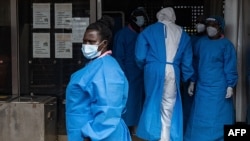For more on the Ebola outbreak in Uganda, VOA’s Carol Van Dam spoke to Dr. Amesh Adalja, an infectious disease expert at John Hopkins Center for Global Health.
The interview was edited for brevity and clarity.
VOA: What symptoms do people experience when they contract Ebola?
Adalja: It starts with fevers, chills, muscle aches, pains and a sore throat.
What happens during that period is that the person’s body is being infected with the virus and eventually that infection affects the blood vessels, and the blood pressure will plummet. They may have sever vomiting, diarrhea and in certain cases may have massive interference with the ability of their blood to clot.
This can have a fatality rate that ranges in the 60-70% ballpark, depending on how quickly people are linked to treatment, so it is a very sever illness.
VOA: Tell me more about the situation in Uganda. How is Ebola spreading?
Adalja: Ebola is very scary and deadly disease, but it is not very contagious.
It requires blood and body fluid exposure, so this is close contact among people like family members, health care workers who are not wearing personal protective equipment.
It is about ensuring that people have the necessary personal protective equipment to take care of patients, and that usually helps stop Ebola outbreaks once they understand how people are being infected and put public health measures into place.
Uganda is no stranger to Ebola outbreaks. They have had them in the past, so they know how to do this. It is a question of getting all those resources and mobilizing in a time when a lot of public health resources have been diverted towards COVID-19.
VOA: What should Ugandan authorities and those in neighboring countries be doing to prevent this Ebola strain from spreading?
Adalja: The first thing they need to do is increase awareness.
People must be cognizant of the fact that this virus is spreading in Uganda and bordering countries should be looking out for cases that may or may not be consistent with Ebola.
They must also de-mystify this disease to the public to stop myths about the virus from spreading. They must tell people how one contracts it and what protective actions can be taken.
They also must make sure that local health workers have the resources to be able to find and diagnose cases while taking care of those cases in places where there is less risk of contagion.
Traditionally, we have seen health care workers get infected with Ebola because they do not have adequate supplies to take care of those patients. That will be needed.
What we do not want to see is draconian measures, travel bans or border closures. We do not want people to get into a situation where they are trying to hide Ebola cases like we saw in West Africa.
Fortunately, Uganda is a place that has had Ebola, so it does not have the same issue. But we have seen a lot of those authoritarian measures and violence occur in West Africa back in 2013-2014, as well as in the DRC with some outbreaks that have occurred in recent years.

